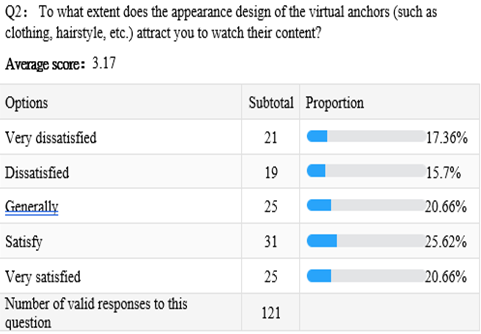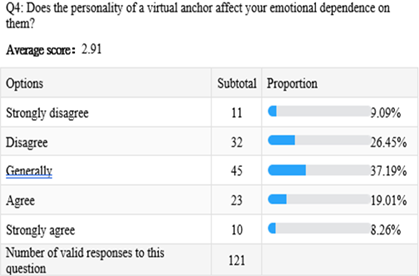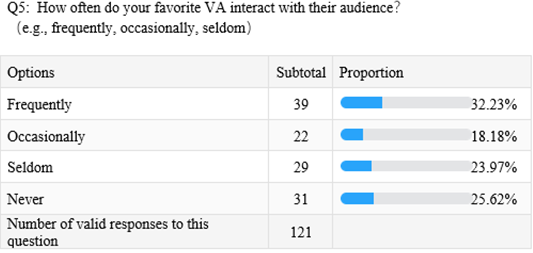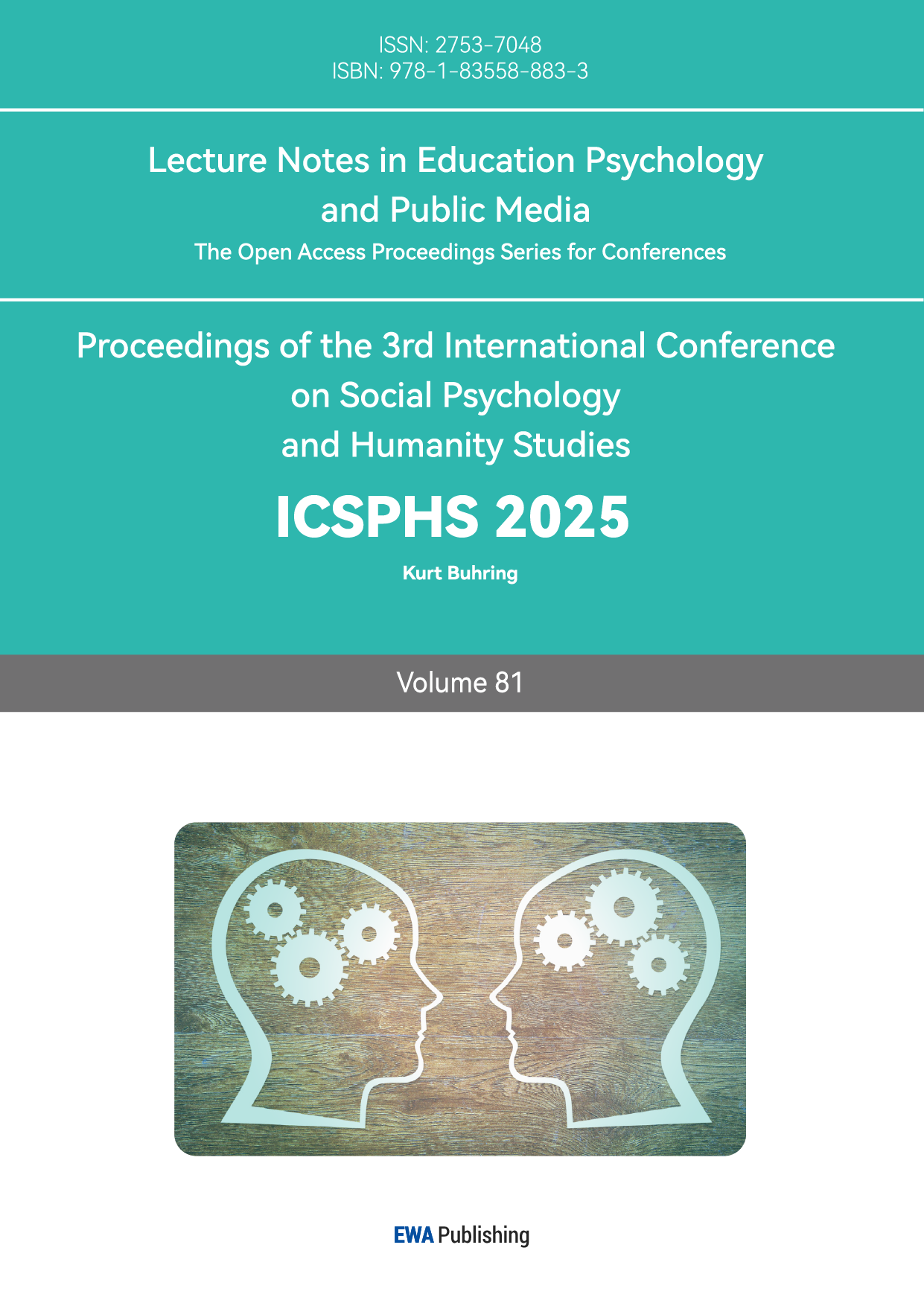1. Introduction
Virtual anchors, which are virtual personas controlled by AI or a human operator, have gained popularity in digital media, particularly on streaming platforms [1]. This kind of virtual character opens new avenues for audiences to interact with the content and enables emotional attachments and attachment behaviors. While there is substantial research present in the field of human-media interaction, the psychological projection of viewers on virtual anchors remains an area of relative darkness. The so-called psychological projection may turn out to be the powerful influence of projecting one's feelings, desires, or traits onto others in the way viewers engage with and relate to these digital figures [2]. The study researches the psychological projection of viewers onto virtual anchors and how this variously affects viewer attachment behavior. The particular focus of this study will be on emotional attachments made between viewers and virtual presences by exploring a sense of what makes viewers attach to virtual personalities, including appearance, personality, and frequency of interaction. This is a qualitative study based on the measurement of variables through the collection of data via questionnaires. The importance of the study can be articulated as the development of existing knowledge regarding virtual relationships, which may bring useful insights to designing and developing more engaging virtual content. It also contributes to the ever-expanding knowledge base on digital interactions and emotional attachment in virtual space.
2. Literature Review
The section revisits the existing literature on two central themes of the research: psychological projection and audience attachment behavior in digital contexts. These areas are essential for understanding how virtual anchors elicit emotional connections and foster long-term viewer attachment.
Psychological projection, as articulated by Sigmund Freud, refers to an unconscious process whereby individuals attribute their own attitudes, feelings, desires, or traits to others or objects. This concept has been reevaluated, in media contexts, particularly concerning human actors, celebrities, and fictional (eg. movie or television) characters.. With the advent of virtual avatars on streaming platforms, a new dimension of projections emerges. Viewers may project their unfulfilled emotions, traits, or needs onto these virtual personas, thereby establishing connections that transcend the screen. The foundational studies of parasocial interaction (PSI) elucidate psychological projection within virtual settings. Horton and Wohl described PSI as a one-sided relationship in which audiences develop emotional attachments to media personalities [3]. The concept has since been extended to encompass digital influencers and virtual avatars, which occupy a space between reality and fiction. Research indicates that individuals can identify aspects of themselves within these virtual figures, rendering them more relatable and approachable [4]. This projection is further intensified by the unique capacity of virtual anchors to interact in real-time with their audiences, creating a more personalized experience that resonates with the desires and feelings of individual viewers.
Attachment theory, originally formulated to explain emotional bonds in human relationships, has been adapted to explain how audiences form attachments to media figures, including virtual avatars [5]. Audience attachment behavior involves the emotional connections viewers form with virtual anchors through repetitive exposure and interaction. This attachment often culminates in long-term active engagement, wherein viewers develop loyalty and emotional reliance on a chosen virtual host. Several factors contribute to audience attachment in virtual environments. Notably, physical appearance plays a crucial role. For instance, an endearing or visually appealing virtual avatar is likely to sustain viewer interest [6]. Survey results indicated that 35.54% of respondents perceived their favorite virtual host as "very cute," highlighting the role of appearance in initial attraction. Personality also significantly influences attachment. Many virtual anchors have exaggerated personalities, characterized by humor or friendliness, which facilitates emotional bonding. Questionnaire data revealed that 26.45% of participants identified "friendly" as the defining trait of their preferred virtual anchor. Interaction further deepens this emotional connection; virtual anchors can respond to comments and engage in real-time conversations fostering a sense of companionship among audiences. Lastly, the frequency and nature of these interactions are critical determinants of attachment. frequency interactions, such as live chats or comments, enhance emotional attachment by mirroring real-life social experiences. Notably, 25.62% of respondents indicated that interaction with virtual hosts significantly influences their willingness to continue watching [7]. Also, the types of interactions—ranging from specific content-related, game-related livestreams to casual chats—creates emotional commitment among viewers, as they tend to prefer streams that emphasize content that resonates with their personal or emotional needs.
While parasocial relationships and media attachment are widely represented in existing literature, research specifically addressing psychological projection in virtual environments remains limited. Most studies have focused on traditional media figures, leaving a critical gap in understanding how these digital avatars—capable of being programmed to behave in specified ways—shape emotional attachment differently. This research aims to fill this gap by examining the projecting mechanisms of the virtual anchors and their influence on audience behavior.
3. Methods
The section outlines the research design, methods of data collection, and procedures of data analysis that are necessary in the investigation of the psychological projection of virtual anchors and subsequent attachment behaviors of the audience. This study employed a quantitative research design utilizing a structured questionnaire survey for data collection. A total of 150 questionnaires were distributed, yielding 133 completed responses, with 121 valid submissions retained for analysis. The demographic analysis revealed a predominant concentration of respondents within the adolescent and young adult age ranges, indicating that the average consumer tends to be younger. Notably, among individuals with similar educational backgrounds, males exhibited a higher propensity than females to develop emotional dependence on virtual anchors and spend money on them. The questionnaire was designed to explore the interactions among various variables. It assessed the use of virtual anchors and the identification of attachment with digital personas, examining how these factors supersede traditional physical casting. Additionally, the study investigates psychological projection to understand how individuals project their emotions or characteristics onto The questionnaire, comprising 22 multiple-choice questions and Likert scale items, was designed to explore the interactions among various variables, including the use of virtual anchors and attachment to digital personas, and to examine how these factors supersede traditional physical casting. Additionally, it investigated psychological projection, focusing on how individuals project their emotions or characteristics onto virtual anchors and their interactive behaviors concerning audience engagement. This comprehensive approach enabled a multidimensional understanding of attachment, encompassing emotional,cognitive, and behavioral components. Data analysis involved descriptive statistics to summarize the distribution of responses, such as the percentage of participants reporting emotional attachment to their favorite virtual anchor. Inferential statistics were used to explore relationships between variables, such as the impact of interaction frequency on attachment. This analysis illuminated the strength and direction of these associations, thereby elucidating the effects of psychological projection on attachment behaviors.
4. Findings
This chapter presents the key findings derived from questionnaire data on how psychological projection onto virtual anchors influences audience attachment behavior. It illustrates how viewers develop attachments to virtual anchors based on factors such as looks, personality traits, and interaction frequency, as displayed in the following figures.


Figure 1: The extent to which virtual anchor’s Figure 2: The impact of a virtual anchor’s
appearance design attracts viewership personality on audience’s emotional dependence

Figure 3: The frequency of interaction of favorite virtual anchors with the audience
Psychological projection emerged as a crucial factor in the virtual anchor's attachment to the viewers. The data indicates that 64.46% of respondents expressed moderate or higher willingness to project their emotional selves and personalities onto their favorite virtual anchors, which seems to increase the emotional tie. For example, 35.54% of the respondents reported their favorite virtual anchor's design as "very cute," which presupposes that physical appearance is a significant factor in making them watch and start emotional engagement. Furthermore, in the responses, it can also be observed that viewers ascribe such personality traits to virtual anchors as "friendly" and "humorous," which perhaps reflect certain traits in the viewers themselves. These can easily allow the viewers to project their emotional needs or desires onto the virtual host, attaching to him or her more emotionally. Interestingly, 37.19% of respondents remained neutral as to whether the virtual host's personality influenced their emotional attachment. This might show that while the personality is almost essential, it cannot be the sole driver of attachment behavior.
In terms of audience attachment behavior, the results showed that the attitude toward virtual anchors is dependent on many factors, including appearance, interaction frequency, and content type. Viewers who frequently interact with virtual hosts through live chats or comments reported having much stronger emotional connections. Humans rely heavily on our senses to navigate the world around us. Appearance plays a vital role in communication. Our first impression is based on how we look. Appearance is typically the first level of engagement that influences perceptions and emotions. When someone is visually impacting or memorable, it can grab one's attention and cause that person to want a follow-up conversation. It can be observed that 25.62% of the subjects consider interaction with virtual anchors to have influenced their willingness to continue watching, while 32.23% reported the frequency of interactions as "frequent." This may mean that real-time communication between virtual anchors and viewers stands at the heart of emotional reliance and attachment. In contrast, 23.97% of the survey respondents reported "almost none" or "never" interacting with the virtual anchors, yet showing emotional connectedness. This underlies the complexity of the attachment process, where even passive audiences form strong emotional contact with virtual anchors based on other aspects, such as looks or style of content. As an example, 33.06% of all respondents who preferred "game livestreams" and "chat sessions"-type content also manifested higher levels of attachment to the virtual anchors, regardless of the frequency of interaction.
The tendencies of the research on the dependence of viewers on virtual anchors are quite interesting. While only 6.61% agreed with the statement that they emotionally rely on their favorite virtual anchor because he or she is so expressive emotionally-despite showing care about viewers, for instance-the majority of 41.32% remained neutral. It indicates that though the emotional dependence is attached, it is not the leading attribute causing viewer attachment; rather, other factors such as personality trait or appearance might considerably of more importance. Furthermore, this shows that the style of content also impacts emotional dependency. For instance, 23.97% of the respondents felt that the style of the content of virtual anchors made them more emotionally dependent on the anchor, while the rest were neutral or disagreed. This befits the literature, where it is postulated that content intended and prepared to appeal to the emotions, like personal testimony or high-charged emotional interactions, would create a closer attachment among viewers.
In summary, the results from the questionnaire survey indicated that psychological projection, appearance, personality, interaction frequency, and content style vary within a very important role in determining audience attachment to virtual anchors. Meanwhile, through analysis, it is found that viewers have complex emotional connections with virtual anchors driven by active interaction and passive consumption together. Although not every one of these viewers interacts regularly, emotional attachment remains strong, indicating that a virtual anchor can certainly provoke high levels of emotional responses from different viewer segments.
5. Discussion
This section contextualizes the findings from the previous section with relevance to the research objectives and wider context of psychological projection and audience attachment behavior. The discussion will look at the implications of these findings and their related relevance within the nascent field of virtual anchors and consider limitations and possible future avenues for research.
The conclusions of this research confirm that psychological projection is one of the listed reasons for audiences to form attachments to virtual anchors [8]. Normally, viewers' emotional involvement in virtual anchors results from unconscious projections of their desires, emotions, and personality traits onto these digital figures. This corresponds with the very notion of psychological projection, which assumes that people generally project their feelings or characteristics onto other individuals because of the inability to cope with an inner conflict or gratify a forbidden desire. Projection, in this case, is most effective with virtual anchors since these digital figures exist in spaces that are both flexible and semi-fictional, allowing viewers to project and fill in emotional gaps in whatever way they might need [9]. The fact that such a high percentage of viewers rated their favorite virtual anchors as "very cute" or in possession of desirable traits like "friendly" or "humorous" suggests that virtual anchors, through appearance and personality build-up, can act as emotional mirrors. This may imply that virtual content creators intentionally design anchors to elicit stronger emotional connections by overemphasizing qualities that fall within common emotional projections. However, the results of the present study also indicate that personality traits are an important but not sole driving force for attachment. The neutrality of 37.19% of the respondents with regard to the personality of a virtual host and how it influences their attachment might suggest that other factors, such as interaction frequency and appearance, might play an equally significant role. Maybe this would bring some insight into how virtual anchors can be developed; after all, a holistic approach in terms of appearance, personality, and interaction strategies seems to be inescapable, given the purpose of building up emotional connections with their viewers.
These findings on audience attachment behaviour provide significant clues on how and why audiences become emotionally attached to virtual anchors [10]. As indicated in the cases, frequent interactions, such as replying to comments and engaging in live chats, enhance emotional closeness between audiences and virtual anchors. It would fall under the literature of parasocial relationship studies, which perceived that direct interaction enhances closeness and loyalty. However, it also turned out in this study that emotional attachment does not rely solely on frequency of interaction [11]. In fact, a fairly sizable percentage of the minimal users of virtual anchors still reported emotional attachment. That is to say, passive consumption-that is, mere viewing without direct interaction-can also cultivate attachment, impelled by factors such as the appearance of the virtual anchor or the type of content [12]. This finding extends the conventional understanding of audience behavior by pointing out that viewers engage in various actions with virtual figures. There had been emotional dependence on virtual anchors; it was, however, not as prominent as could be expected. Most of the responses were neutral on questions assessing emotional dependence on virtual anchors. Only 6.61% strongly agreed to the statement, "Virtual anchors fulfill emotional needs." It therefore seems that virtual anchors may indeed build emotional connections, but these may not run as deep as in real-world relationships [13]. The virtual anchors perhaps act more as temporal emollient or an emotional companion than figures with deep emotional reliance.
Another profound insight from the research was the content style on which viewership dependency was based [14]. Viewers whose preferences are for emotionally appealing content, like chat sessions or personal interactions, would be more likely to report emotional attachment and dependency on virtual anchors. This thus justifies the reason why more emotionally evocative content, like live interactions or personal storytelling, would have a greater possibility of stirring deeper emotional connections with viewers [15]. Therefore, virtual content should be specially created to appeal to the emotional needs of audiences, particularly those who use digital media for companionship or emotional engagement [16].
6. Conclusion
This study explores the role of psychological projection in audience attachment to virtual anchors. It reveals that viewers often project their emotions and personality onto these digital figures, thereby strengthening their emotional bonds. Key determinants of this attachment include the virtual anchor’s appearance, personality, and frequency of interaction, with real-time engagement playing a central role. Notably, even viewers who engage minimally report strong emotional attachments, indicating indicating a complex, multi-dimensional relationship. Virtual anchors, particularly in emotionally resonant content, provide viewers with immediate comfort and companionship, fulfilling short-term emotional needs rather than deep emotional dependency. Studies show that content designed to elicit emotional responses fosters stronger connections, suggesting that virtual content creators can enhance engagement by aligning avatar design and content style with audience emotional expectations. The rise of virtual anchors as online companions reflects broader societal trends, offering solace to individuals experiencing loneliness, anxiety, or stress in today’s fast-paced world. They cater to audiences seeking emotional release from conventional social pressures, serving as a comforting presence in a digital environment. As digital platforms continue to evolve, the role of virtual anchors may expand, potentially collaborating with fields such as mental health support. This progression underscores the potential for virtual anchors to positively impact emotional well-being, demonstrating the importance of emotional connection in an increasingly digital society. Further research is necessary to examine the long-term implications of these emotional bonds. Qualitative studies could offer deeper insights into these dynamics, informing content strategies that prioritize meaningful, viewer-centered experiences. As society becomes increasingly digitized, virtual anchors may redefine approaches to emotional support and mental health in the digital age.
References
[1]. Zhang, L., & Ren, J. (2022). Virtual Influencers: The effects of controlling entity, appearance realism and product type on advertising effect. In Lecture notes in computer science (pp. 298–305).
[2]. Yates, C. (2018). Psychoanalysis and television: notes towards a psycho-cultural approach. In Television and Psychoanalysis (pp. 1-28). Routledge.
[3]. Horton, D., & Wohl, R. R. (1956). Mass communication and para-social interaction: Observations on intimacy at a distance. Psychiatry, 19(3), 215-229.
[4]. Giles, D. C. (2002). Parasocial interaction: A review of the literature and a model for future research. Media Psychology, 4(3), 279-305.
[5]. Bowlby, J. (1969). Attachment and loss: Vol. 1. Attachment. Basic Books.
[6]. Lee, K., Choi, M., & Kim, Y. (2020). The effect of avatar appearance on parasocial interaction and loyalty in video streaming services. Telematics and Informatics, 49, 101381.
[7]. Rihl, A., & Wegener, C. (2019). YouTube celebrities and parasocial interaction: Using feedback channels in mediatized relationships. Convergence, 25(3), 554-566.
[8]. Zhao, X. (2024). Research on factors influencing the rewarding behavior of virtual anchors’ fans. In Applied economics and policy studies (pp. 544–554).
[9]. El Refaie, E. (2019). Visual metaphor and embodiment in graphic illness narratives. Oxford University Press, USA.
[10]. Li, L., Chen, X., & Zhu, P. (2024). How do e-commerce anchors’ characteristics influence consumers’ impulse buying? An emotional contagion perspective. Journal of Retailing and Consumer Services, 76, 103587.
[11]. Yip, J., Ehrhardt, K., Black, H., & Walker, D. O. (2017). Attachment theory at work: A review and directions for future research. Journal of Organizational Behavior, 39(2), 185–198.
[12]. Zhang, Y., & Wang, X. (2024). The effect of virtual anchor appearance on purchase intention: a perceived warmth and competence perspective. Journal of Product & Brand Management.
[13]. Sluiter, I., & Versluys, M. J. (2022). Anchoring. In Springer eBooks (pp. 95–99).
[14]. Steiner, E., & Xu, K. (2018). Binge-watching motivates change: Uses and gratifications of streaming video viewers challenge traditional TV research. Convergence the International Journal of Research Into New Media Technologies, 26(1), 82–101.
[15]. Nicoli, N., Henriksen, K., Komodromos, M., & Tsagalas, D. (2021). Investigating digital storytelling for the creation of positively engaging digital content. EuroMed Journal of Business, 17(2), 157–173.
[16]. Hansen, S. M. (2021, June 2). The Digital Audience - How social media platforms encourage behavior between content creators and their audiences.
Cite this article
Zhang,C. (2025). Research on the Psychological Projection of Virtual Anchors and the Audience's Attachment Behaviour. Lecture Notes in Education Psychology and Public Media,81,1-7.
Data availability
The datasets used and/or analyzed during the current study will be available from the authors upon reasonable request.
Disclaimer/Publisher's Note
The statements, opinions and data contained in all publications are solely those of the individual author(s) and contributor(s) and not of EWA Publishing and/or the editor(s). EWA Publishing and/or the editor(s) disclaim responsibility for any injury to people or property resulting from any ideas, methods, instructions or products referred to in the content.
About volume
Volume title: Proceedings of the 3rd International Conference on Social Psychology and Humanity Studies
© 2024 by the author(s). Licensee EWA Publishing, Oxford, UK. This article is an open access article distributed under the terms and
conditions of the Creative Commons Attribution (CC BY) license. Authors who
publish this series agree to the following terms:
1. Authors retain copyright and grant the series right of first publication with the work simultaneously licensed under a Creative Commons
Attribution License that allows others to share the work with an acknowledgment of the work's authorship and initial publication in this
series.
2. Authors are able to enter into separate, additional contractual arrangements for the non-exclusive distribution of the series's published
version of the work (e.g., post it to an institutional repository or publish it in a book), with an acknowledgment of its initial
publication in this series.
3. Authors are permitted and encouraged to post their work online (e.g., in institutional repositories or on their website) prior to and
during the submission process, as it can lead to productive exchanges, as well as earlier and greater citation of published work (See
Open access policy for details).
References
[1]. Zhang, L., & Ren, J. (2022). Virtual Influencers: The effects of controlling entity, appearance realism and product type on advertising effect. In Lecture notes in computer science (pp. 298–305).
[2]. Yates, C. (2018). Psychoanalysis and television: notes towards a psycho-cultural approach. In Television and Psychoanalysis (pp. 1-28). Routledge.
[3]. Horton, D., & Wohl, R. R. (1956). Mass communication and para-social interaction: Observations on intimacy at a distance. Psychiatry, 19(3), 215-229.
[4]. Giles, D. C. (2002). Parasocial interaction: A review of the literature and a model for future research. Media Psychology, 4(3), 279-305.
[5]. Bowlby, J. (1969). Attachment and loss: Vol. 1. Attachment. Basic Books.
[6]. Lee, K., Choi, M., & Kim, Y. (2020). The effect of avatar appearance on parasocial interaction and loyalty in video streaming services. Telematics and Informatics, 49, 101381.
[7]. Rihl, A., & Wegener, C. (2019). YouTube celebrities and parasocial interaction: Using feedback channels in mediatized relationships. Convergence, 25(3), 554-566.
[8]. Zhao, X. (2024). Research on factors influencing the rewarding behavior of virtual anchors’ fans. In Applied economics and policy studies (pp. 544–554).
[9]. El Refaie, E. (2019). Visual metaphor and embodiment in graphic illness narratives. Oxford University Press, USA.
[10]. Li, L., Chen, X., & Zhu, P. (2024). How do e-commerce anchors’ characteristics influence consumers’ impulse buying? An emotional contagion perspective. Journal of Retailing and Consumer Services, 76, 103587.
[11]. Yip, J., Ehrhardt, K., Black, H., & Walker, D. O. (2017). Attachment theory at work: A review and directions for future research. Journal of Organizational Behavior, 39(2), 185–198.
[12]. Zhang, Y., & Wang, X. (2024). The effect of virtual anchor appearance on purchase intention: a perceived warmth and competence perspective. Journal of Product & Brand Management.
[13]. Sluiter, I., & Versluys, M. J. (2022). Anchoring. In Springer eBooks (pp. 95–99).
[14]. Steiner, E., & Xu, K. (2018). Binge-watching motivates change: Uses and gratifications of streaming video viewers challenge traditional TV research. Convergence the International Journal of Research Into New Media Technologies, 26(1), 82–101.
[15]. Nicoli, N., Henriksen, K., Komodromos, M., & Tsagalas, D. (2021). Investigating digital storytelling for the creation of positively engaging digital content. EuroMed Journal of Business, 17(2), 157–173.
[16]. Hansen, S. M. (2021, June 2). The Digital Audience - How social media platforms encourage behavior between content creators and their audiences.









